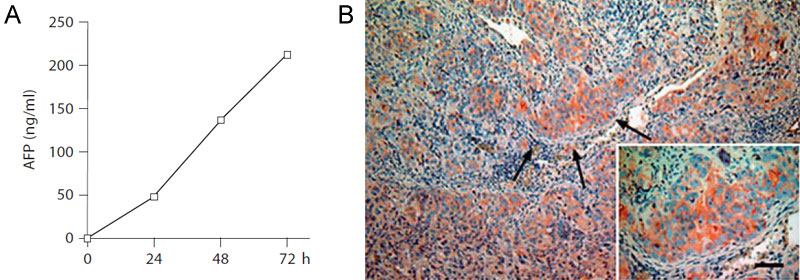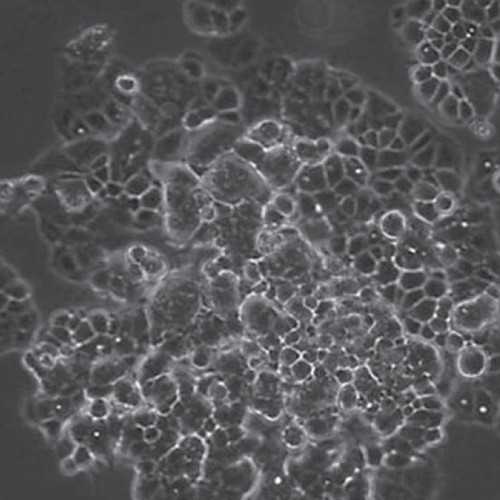Human Ovarian Yolk Sac Tumor Cell Line NOY1
The NOY1 cell line is a novel ovarian yolk sac tumor (YST) model useful for malignant ovarian germ cell tumor (MOGCT) research. NOY1 originated from the YST of a 28-year-old female. Tumor cells were collected via right salpingo oophorectomy and passaged 50 times in order to establish the NOY1 cell line.
Yolk sac (endodermal sinus) tumors are highly malignant ovarian germ cell tumors with characteristic expression of alpha-fetoprotein (AFP, also known as alpha-1-fetoprotein and alpha-fetoglobulin), a biomarker for germ cell tumors and other hepatocellular cancers. The NOY1 cell line has been shown to form tumors in vivo; nude mice injected with NOY1 cells developed peritoneal disseminations, which stained positive for AFP via immunohistochemistry.
From a laboratory at Nagoya University.
The NOY1 cell line is a novel ovarian yolk sac tumor (YST) model useful for malignant ovarian germ cell tumor (MOGCT) research. NOY1 originated from the YST of a 28-year-old female. Tumor cells were collected via right salpingo oophorectomy and passaged 50 times in order to establish the NOY1 cell line.
Yolk sac (endodermal sinus) tumors are highly malignant ovarian germ cell tumors with characteristic expression of alpha-fetoprotein (AFP, also known as alpha-1-fetoprotein and alpha-fetoglobulin), a biomarker for germ cell tumors and other hepatocellular cancers. The NOY1 cell line has been shown to form tumors in vivo; nude mice injected with NOY1 cells developed peritoneal disseminations, which stained positive for AFP via immunohistochemistry.
From a laboratory at Nagoya University.
| Product Type: | Cell Line |
| Name: | NOY1 |
| Cell Type: | Ovarian Yolk Sac Tumor |
| Accession ID: | CVCL_0P30 |
| Organism: | Human |
| Source: | Human right ovary/yolk sac |
| Morphology: | Epithelial-like |
| Biosafety Level: | BSL-1 |
| Growth Conditions: | RPMI-1640 medium, 5% Fetal Bovine Serum, 100U/mL penicillin G, 100 ug/mL streptomycin |
| Subculturing: | A subcultivation ratio of 1:2 to 1:6 is recommended |
| Cryopreservation: | Complete growth medium supplemented with 5% (v/v) DMSO |
| Storage: | Liquid nitrogen |
| Shipped: | Dry ice |
AFP Expression in NOY1 Human Ovarian Yolk Sac Tumor Cells

(A) AFP levels quantified by ELISA in the culture medium of NOY1 cells after 3 days. (B) Immunohistochemical analysis of AFP expression in the tumor cells of mice (magnification, x200 and x400). Scale bar = 20 um.
Adapted from: "Establishment and Characterization of an Ovarian Yolk Sac Tumor Cell Line Reveals Possible Involvement of Nkx2.5 in Tumor Development", K. Shibata, H. Kajiyama, et al., Oncology 2008; 74: 104 - 111.
Subculturing Protocol
A subcultivation ratio of 1:2 to 1:6 is recommended. Medium should be renewed 2-3 times per week.
- Remove and discard culture medium.
- Briefly rinse the cell layer with 0.25% (w/v) Trypsin- 0.53 mM EDTA solution to remove all traces of serum that contains trypsin inhibitor.
- Add 2.0 to 3.0 mL of Trypsin-EDTA solution to flask and observe cells under an inverted microscope until cell layer is dispersed (usually within 5 to 15 minutes). Note: To avoid clumping do not agitate the cells by hitting or shaking the flask while waiting for the cells to detach. Cells that are difficult to detach may be placed at 37°C to facilitate dispersal.
- Add 6.0 to 8.0 mL of complete growth medium and aspirate cells by gently pipetting.
- Add appropriate aliquots of the cell suspension to new culture vessels.
- Incubate cultures at 37°C.
- "Establishment and Characterization of an Ovarian Yolk Sac Tumor Cell Line Reveals Possible Involvement of Nkx2.5 in Tumor Development", K. Shibata, H. Kajiyama, et al., Oncology 2008; 74: 104 - 111.
- "Establishment of Cisplatin-Resistant Ovarian Yolk Sac Tumor Cells and Investigation of the Mechanism of Cisplatin Resistance Using This Cell Line", K. Shibata, T. Umezu, et al., Gynecol Obstet Invest 2011: 71: 104 - 111.
- "Functional interaction between peritoneal mesothelial cells and stem cells of ovarian yolk sac tumor (SC-OYST) in peritoneal dissemination", H. Mitsui, K. Shibata, et al., Gynecologic Oncology 2012; 124: 303 - 310.
- Schmidtova S, Dorssers LCJ, Kalavska K, et al. Napabucasin overcomes cisplatin resistance in ovarian germ cell tumor-derived cell line by inhibiting cancer stemness. Cancer Cell Int. 2020;20:364. Published 2020 Aug 3. View article
- Krasnik V, Furdova A, Svetlosakova Z, Kobzova D, Gergisakova H, Feketeova L, Svetlosak M, Barta A, Babal P. Prognostic value of apoptosis inducing factor in uveal melanoma. Neoplasma. 2017;64(2):262-268. View article
If you publish research with this product, please let us know so we can cite your paper.


